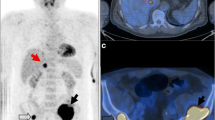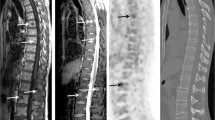Abstract
ᅟ
FDG PET/CT (18F-fluoro-deoxy-glucose positron emission tomography/computed tomography) is a useful tool to image multiple myeloma (MM). However, simple and reproducible reporting criteria are still lacking and there is the need for harmonization. Recently, a group of Italian nuclear medicine experts defined new visual descriptive criteria (Italian Myeloma criteria for Pet Use: IMPeTUs) to standardize FDG PET/CT evaluation in MM patients. The aim of this study was to assess IMPeTUs reproducibility on a large prospective cohort of MM patients.
Materials and methods
Patients affected by symptomatic MM who had performed an FDG PET/CT at baseline (PET0), after induction (PET-AI), and the end of treatment (PET-EoT) were prospectively enrolled in a multicenter trial (EMN02)(NCT01910987; MMY3033). After anonymization, PET images were uploaded in the web platform WIDEN® and hence distributed to five expert nuclear medicine reviewers for a blinded independent central review according to the IMPeTUs criteria. Consensus among reviewers was measured by the percentage of agreement and the Krippendorff’s alpha. Furthermore, on a patient-based analysis, the concordance among all the reviewers in terms of positivity or negativity of the FDG PET/CT scan was tested for different thresholds of positivity (Deauville score (DS 2, 3, 4, 5) for the main parameters (bone marrow, focal score, extra-medullary disease).
Results
Eighty-six patients (211 FDG PET/CT scans) were included in this analysis. Median patient age was 58 years (range, 35–66 years), 45% were male, 15% of them were in stage ISS (International Staging System) III, and 42% had high-risk cytogenetics. The percentage agreement was superior to 75% for all the time points, reaching 100% of agreement in assessing the presence skull lesions after therapy. Comparable results were obtained when the agreement analysis was performed using the Krippendorff’s alpha coefficient, either in every single time point of scanning (PET0, PET-AI or PET-EoT) or overall for all the scans together. DS proved highly reproducible with the highest reproducibility for score 4.
Conclusions
IMPeTUs criteria proved highly reproducible and could therefore be considered as a base for harmonizing PET interpretation in multiple myeloma. A prospective clinical validation of IMPeTUs criteria is underway.

Similar content being viewed by others
References
Cavo M, Terpos E, Nanni C, Moreau P, Lentzsch S, Zweegman S, et al. Role of 18F-FDG PET/CT in the diagnosis and management of multiple myeloma and other plasma cell disorders: a consensus statement by the International Myeloma Working Group. Lancet Oncol. 2017;18(4):e206–17.
Zamagni E, Patriarca F, Nanni C, Zannetti B, Englaro E, Pezzi A, et al. Prognostic relevance of 18-F FDG PET/CT in newly diagnosed multiple myeloma patients treated with up-front autologous transplantation. Blood. 2011;118(23):5989–95.
Bartel TB, Haessler J, Brown TLY, Shaughnessy JDJ, van Rhee F, Anaissie E, et al. F18-fluorodeoxyglucose positron emission tomography in the context of other imaging techniques and prognostic factors in multiple myeloma. Blood. 2009;114(10):2068–76.
Falcone C, Cipullo S, Sannino P, Restuccia A. Whole body magnetic resonance and CT/PET in patients affected by multiple myeloma during staging before treatment. Recenti Prog Med. 2012;103(11):444–9.
Derlin T, Peldschus K, Munster S, Bannas P, Herrmann J, Stubig T, et al. Comparative diagnostic performance of (1)(8)F-FDG PET/CT versus whole-body MRI for determination of remission status in multiple myeloma after stem cell transplantation. Eur Radiol. 2013;23(2):570–8.
Fonti R, Larobina M, Del Vecchio S, De Luca S, Fabbricini R, Catalano L, et al. Metabolic tumor volume assessed by 18F-FDG PET/CT for the prediction of outcome in patients with multiple myeloma. J Nucl Med. 2012;53(12):1829–35.
Mesguich C, Fardanesh R, Tanenbaum L, Chari A, Jagannath S, Kostakoglu L. State of the art imaging of multiple myeloma: comparative review of FDG PET/CT imaging in various clinical settings. Eur J Radiol. 2014;83(12):2203–23.
Nanni C, Zamagni E, Celli M, Caroli P, Ambrosini V, Tacchetti P, et al. The value of 18F-FDG PET/CT after autologous stem cell transplantation (ASCT) in patients affected by multiple myeloma (MM): experience with 77 patients. Clin Nucl Med. 2013;38(2):e74–9.
Nanni C, Zamagni E, Versari A, Chauvie S, Bianchi A, Rensi M, et al. Image interpretation criteria for FDG PET/CT in multiple myeloma: a new proposal from an Italian expert panel. IMPeTUs (Italian myeloma criteria for PET USe). Eur J Nucl Med Mol Imaging. 2016;43(3):414–21.
Barrington SF, Mikhaeel NG. When should FDG-PET be used in the modern management of lymphoma? Br J Haematol. 2014;164(3):315–28.
Biggi A, Gallamini A, Chauvie S, Hutchings M, Kostakoglu L, Gregianin M, et al. International validation study for interim PET in ABVD-treated, advanced-stage Hodgkin lymphoma: interpretation criteria and concordance rate among reviewers. J Nucl Med. 2013;54(5):683–90.
Gallamini A, Barrington SF, Biggi A, Chauvie S, Kostakoglu L, Gregianin M, et al. The predictive role of interim positron emission tomography for Hodgkin lymphoma treatment outcome is confirmed using the interpretation criteria of the Deauville five-point scale. Haematologica. 2014;99(6):1107–13.
Cavo M, Gobbi M, Potamianu A, Lahaye M, Couturier C, Terpos E. Evaluation of experimental retreatment and prolonged therapy with subcutaneous (SC) bortezomib in patients (Pts) with multiple myeloma in first or second relapse, a randomized, controlled, phase 3 study. In 2016. p. 3328.
Boellaard R, Delgado-Bolton R, Oyen WJG, Giammarile F, Tatsch K, Eschner W, et al. FDG PET/CT: EANM procedure guidelines for tumour imaging: version 2.0. Eur J Nucl Med Mol Imaging. 2015;42(2):328–54.
Hayes AF, Krippendorff K. Answering the call for a standard reliability measure for coding data. Answering the call for a standard reliability measure for coding data. Commun Method Meas. 2007;1:77–89. 33
Chauvie S, Biggi A, Stancu A, Cerello P, Cavallo A, Fallanca F, et al. WIDEN: a tool for medical image management in multicenter clinical trials. Clin Trials. 2014;11(3):355–61.
Nanni C, Cottereau AS, Lopci E, Bodet-Milin C, Coronado M, Pro B, et al. Report of the 6th International Workshop on PET in Lymphoma. Leuk Lymphoma. 2017;58(10):2298–303.
Author information
Authors and Affiliations
Corresponding author
Ethics declarations
Conflict of interest
The authors declare that they have no conflicts of interest.
Research involving human participants
All procedures performed in studies involving human participants were in accordance with the ethical standards of the institutional and/or national research committee and with the 1964 Helsinki Declaration and its later amendments or comparable ethical standards.
Informed consent
All the patients signed a specific informed consent.
Rights and permissions
About this article
Cite this article
Nanni, C., Versari, A., Chauvie, S. et al. Interpretation criteria for FDG PET/CT in multiple myeloma (IMPeTUs): final results. IMPeTUs (Italian myeloma criteria for PET USe). Eur J Nucl Med Mol Imaging 45, 712–719 (2018). https://doi.org/10.1007/s00259-017-3909-8
Received:
Accepted:
Published:
Issue Date:
DOI: https://doi.org/10.1007/s00259-017-3909-8




